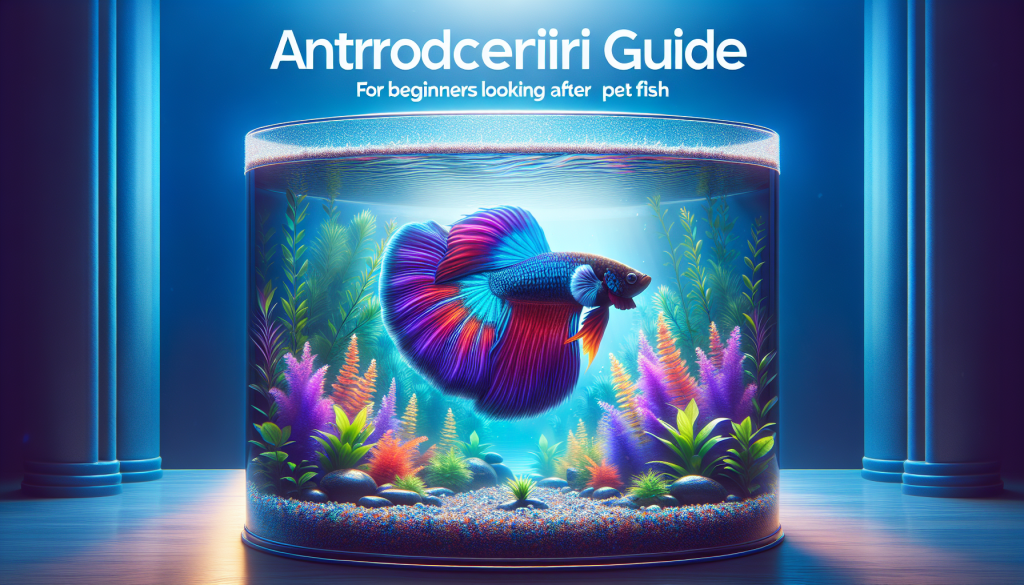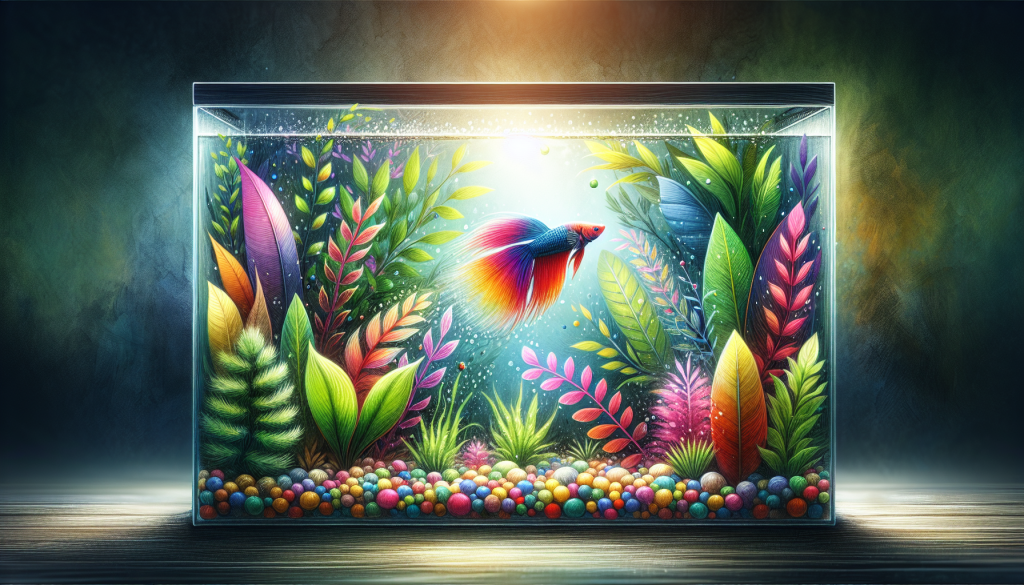If you’re thinking of bringing a new pet into your life and have decided on a fish, congratulations! Caring for a pet fish can be a rewarding and enjoyable experience. Whether you’re a first-time pet owner or just new to the world of fishkeeping, this beginner’s guide will provide you with all the essential information you need to ensure that your finned friend lives a happy and healthy life. From setting up the perfect aquarium to understanding their feeding requirements and maintaining their habitat, this guide will cover everything you need to know to become a successful fish owner. So, get ready to dive into the wonderful world of fishkeeping and create a thriving environment for your new aquatic companion.
Table of Contents
ToggleChoosing the Right Fish
Consider your experience level
When choosing a fish as a pet, it is essential to consider your experience level. If you are a beginner, it is best to start with low-maintenance fish that are hardy and can tolerate a wide range of water conditions. Some excellent beginner fish species include Betta fish, guppies, goldfish, and platies. These fish are relatively easy to care for and can adapt well to different tank environments.
Research different fish species
Before selecting a fish, take the time to research different species and their specific care requirements. Each fish has unique needs in terms of temperature, tank size, water conditions, and diet. Make sure to choose fish that are compatible both in terms of their care requirements and temperament. Some fish may be prone to aggression and may not get along well with others. By conducting thorough research, you can ensure that you choose fish that are a good fit for your tank and your level of experience.
Determine the appropriate tank size
The size of the tank is an essential factor to consider when setting up a fish tank. Different fish species have different space requirements, and it is crucial to provide them with enough room to swim and thrive. A general rule of thumb is to have a gallon of water for each inch of the fish’s body length. However, keep in mind that some fish species may require more space due to their active nature. It is always better to opt for a larger tank size than to overcrowd your fish, as this can lead to stress and poor water quality.
Setting up the Fish Tank
Selecting the right tank
When setting up a fish tank, it is crucial to choose the right tank size and shape. Consider the available space in your home and select a tank that fits comfortably in the designated area. Ensure that the tank has a sturdy stand or surface to prevent any accidents. Additionally, consider the material of the tank. Glass tanks are highly preferred as they are durable and provide excellent visibility. Acrylic tanks are also a good option, but they may scratch more easily. Choose a tank that suits both your budget and the needs of your fish.
Cleaning and preparing the tank
Before adding fish to the tank, it is essential to clean and prepare it properly. Start by rinsing the tank and all accessories, such as gravel and decorations, with warm water. Avoid using any detergents or chemicals as they can be harmful to fish. Once the tank and accessories are clean, add a layer of substrate to the bottom of the tank. It is recommended to use aquarium-specific gravel or sand, as they are designed to be safe for fish. Rinse the substrate thoroughly to remove any dust or debris before placing it in the tank.
Adding the necessary equipment
To create a suitable environment for your fish, it is essential to add the necessary equipment to the tank. This includes a filter, a heater (if required), and a thermometer to monitor the water temperature. Filters are crucial for removing debris and maintaining water quality. Choose a filter that is appropriate for the size of your tank and consider adding additional filtration media, such as activated carbon or biological filtration media, to improve water quality. A heater may be necessary for tropical fish that require a specific water temperature. Make sure to follow the manufacturer’s instructions when installing and setting up these pieces of equipment.
Creating the Ideal Tank Environment
Maintaining the right water temperature
Maintaining the right water temperature is vital for the health and well-being of your fish. Different fish species have different temperature requirements, so it is essential to research and understand the needs of your specific fish. Use a reliable aquarium thermometer to monitor the water temperature regularly. If necessary, invest in a heater to keep the water at the desired temperature range. Avoid sudden fluctuations in temperature, as they can cause stress and illness in fish. Stability is key when it comes to the water temperature in your fish tank.
Choosing the correct substrate
The substrate in your fish tank has both aesthetic and functional purposes. It provides a natural environment for your fish and serves as a medium for beneficial bacteria growth. When choosing a substrate, consider the needs of your fish species. Some fish prefer a sandy substrate, while others may require a gravel or pebbled substrate. Make sure to select a substrate that is safe for your fish and easy to clean. Avoid using substrates that may have sharp edges or contain chemicals that can harm your fish.
Adding appropriate decorations and plants
Decorations and live plants not only enhance the visual appeal of your fish tank but also provide important benefits for your fish. Some fish species appreciate hiding spots and may feel stressed without adequate places to retreat. Adding caves, driftwood, and plants can create a more natural and stimulating environment for your fish. When selecting decorations and plants, consider the specific needs of your fish. Some plants require specific lighting and substrate conditions, so make sure to choose ones that can thrive in your tank setup. Proper decoration placement can help create a harmonious and stress-free environment for your fish.
Understanding Fish Feeding Requirements
Researching the dietary needs of your fish
Proper nutrition is crucial for the health and vitality of your fish. Different fish species have different dietary requirements, so it is essential to research and understand the specific needs of your fish. Some fish are omnivores and require a combination of plant matter and protein-rich foods, while others may be herbivores or carnivores. High-quality fish food pellets or flakes are a good staple diet for most fish species, but supplementing with frozen or live foods can provide additional nutrients and variety. It is important not to overfeed your fish, as excess food can pollute the water and lead to health problems.
Establishing a feeding schedule
Establishing a regular feeding schedule is beneficial for both you and your fish. Most fish do well with two small feedings per day, ensuring that they receive enough food without overeating. Feed your fish at the same times each day to establish a routine. It is important to observe your fish’s behavior during feeding to gauge how much they are eating. If there is uneaten food after a few minutes, you may be giving them more than they can consume. Adjust the amount accordingly to avoid waste and water pollution.
Avoiding overfeeding
One of the most common mistakes that fish owners make is overfeeding their fish. Overfeeding can lead to obesity, poor water quality, and health issues. It is important to remember that fish have small stomachs and do not require large quantities of food. Moderation is key when feeding your fish. Start by giving them a small amount of food and observe how quickly they consume it. If there is still food left after a few minutes, remove the uneaten portion to prevent it from decomposing and polluting the water. It is better to slightly underfeed your fish than to overfeed them.
Maintaining Water Quality
Monitoring ammonia, nitrites, and nitrates
Maintaining excellent water quality is essential for the health and well-being of your fish. Ammonia, nitrites, and nitrates are byproducts of fish waste and decomposing organic matter in the tank. High levels of these substances can be toxic to fish, causing stress, illness, and even death. Regularly test the water parameters using a reliable aquarium test kit. Ammonia and nitrites should ideally be undetectable, while nitrates should be kept at a low level. If any of these levels are too high, it is important to take immediate action to rectify the issue.
Performing regular water changes
Regular water changes are crucial for maintaining optimal water quality. Partial water changes help remove accumulated toxins and replenish essential minerals and nutrients. Aim to change approximately 25% of the water in your tank every 1-2 weeks. Before performing a water change, make sure to treat tap water with a dechlorinator to remove harmful chemicals such as chlorine and chloramines. Use a siphon or a gravel vacuum to remove debris and waste from the substrate during water changes. Remember to replace the water slowly to avoid stressing your fish.
Using water conditioners and filter maintenance
Water conditioners are essential in removing harmful chemicals from tap water and making it safe for your fish. These products neutralize chlorine, chloramines, and heavy metals, ensuring that the water is suitable for fish health. Follow the instructions on the water conditioner bottle for the correct dosage. Additionally, it is important to regularly maintain your fish tank’s filter. Clean or replace the filter media as instructed by the manufacturer to ensure that it functions optimally. A well-maintained filter helps remove debris and biological waste from the water, contributing to better water quality.
Ensuring Proper Lighting and Filtration
Choosing the appropriate lighting
Lighting plays a crucial role in the overall well-being of your fish and the aesthetic appeal of your tank. Different fish species have different lighting requirements, so it is essential to choose the appropriate lighting for your tank. Some fish, such as bettas, prefer lower light conditions, while others may require brighter lighting to thrive. Consider the needs of your fish and select a lighting system that provides the necessary intensity and spectrum. Additionally, it is important to establish a lighting schedule that mimics natural day and night cycles to promote a healthy environment for your fish.
Understanding the importance of filtration
Filtration is vital for maintaining good water quality in your fish tank. A filter helps remove debris, excess food, and fish waste from the water, preventing the accumulation of harmful substances. It also provides a surface for beneficial bacteria to grow, which aid in the breakdown of harmful ammonia and nitrites. When selecting a filter, choose one that is appropriate for the size of your tank and the needs of your fish. It is generally recommended to choose a filter that has a higher flow rate than the minimum requirement for your tank size to ensure efficient filtration.
Cleaning and replacing filters
Regular maintenance of your fish tank’s filter is essential for its proper functioning. Over time, filter media can become clogged with debris and lose its effectiveness. Follow the manufacturer’s instructions on how frequently to clean or replace the filter media. Generally, it is recommended to rinse mechanical filter media, such as sponges, regularly to remove accumulated debris. Chemical filter media, such as activated carbon, may need to be replaced every few weeks to maintain optimal water quality. Regular filter maintenance helps ensure that your filter performs efficiently and keeps your fish tank clean.
Caring for Fish Health
Recognizing signs of illness
As a fish owner, it is crucial to be aware of the common signs of fish illness. Some common signs of illness in fish include loss of appetite, lethargy, frayed fins, abnormal swimming behavior, and visible symptoms such as lesions or discoloration. If you notice any of these signs, it is important to take prompt action. Research the symptoms or consult with a veterinarian or an experienced fish keeper to determine the best course of action for your fish. Early detection and treatment of illness can greatly increase the chances of recovery.
Quarantining new fish
When introducing new fish to your tank, it is highly recommended to quarantine them before adding them to your display tank. Quarantining helps prevent the introduction of diseases or parasites into your main tank. Set up a separate quarantine tank with similar water parameters and conditions as your main tank. Observe the new fish closely during the quarantine period for any signs of illness or stress. This allows you to treat any potential issues without putting your entire tank population at risk. Quarantining new fish is a responsible practice that helps ensure the health of your existing fish and the long-term success of your aquarium.
Consulting with a veterinarian
In some cases, fish may require professional veterinary care. If you notice severe or persistent health issues in your fish, it is important to consult with a veterinarian who specializes in aquatic animals. A veterinarian can accurately diagnose the problem and provide appropriate treatment options. Additionally, they can offer expert advice on fish health and preventive care. Regular check-ups with a veterinarian can help detect and prevent potential health problems, ensuring that your fish remain healthy and thriving.
Understanding Fish Behavior
Learning common fish behaviors
Understanding fish behavior is essential for providing a suitable environment and identifying any potential issues. Fish exhibit a wide range of behaviors, and it is important to learn and recognize their normal actions. Observing your fish regularly will help you understand their preferences, interactions, and feeding habits. Some common behaviors include swimming patterns, schooling or solitary behavior, feeding behaviors, and social interactions. By becoming familiar with your fish’s behaviors, you can quickly identify any changes that may indicate stress or illness.
Identifying stress and aggression
Fish, like any other living beings, can experience stress. Stress in fish may be caused by factors such as poor water conditions, incompatible tank mates, inadequate hiding spots, or sudden changes in the environment. It is important to identify signs of stress in your fish, such as loss of appetite, hiding, increased aggression, or excessive hiding. Stress can weaken the fish’s immune system and make them more susceptible to disease. Additionally, aggression among fish can lead to injuries or even death. It is crucial to take appropriate action to minimize stress and aggression, such as providing suitable hiding spots and ensuring compatible tank mates.
Providing suitable hiding spots
Providing suitable hiding spots in your fish tank is essential for the well-being of your fish. Many species of fish appreciate having places to hide and feel secure, especially when they are feeling stressed or threatened. Hiding spots can be created using various decorations such as caves, tunnels, or dense plants. Consider the specific needs of your fish and provide hiding spots that are appropriate for their size and behavior. Creating hiding spots not only helps reduce stress but also mimics the fish’s natural environment, promoting their overall health and happiness.
Handling and Transporting Fish
Using proper fish handling techniques
Handling fish correctly is crucial to ensure their safety and well-being. When handling fish, it is important to avoid using bare hands, as the natural oils and bacteria on our skin can be harmful to them. Instead, use a clean, wet net or a container for transferring fish. Move slowly and gently to avoid causing unnecessary stress or injury to the fish. If you need to catch a fish for any reason, do so with caution and care. Always have a plan and the necessary equipment, such as a clean, suitable container, to safely transport your fish.
Preparing for transportation
Transporting fish can be a stressful experience for them, but with proper preparation, you can minimize the potential risks. If you need to transport your fish, make sure to plan ahead and gather all the necessary supplies. Prepare a clean, suitable container with a secure lid, such as a plastic bag or a fish transport bag. Fill the container with water from the tank and ensure that there is enough air space for the fish to breathe. If the journey is long or the weather is cold, consider using a portable heater or heat pack to maintain the water temperature. Secure the container and ensure that it is stable to prevent any spills or accidents during transportation.
Acclimating fish to new environments
When introducing fish to a new tank, it is important to acclimate them properly to minimize stress and help them adjust to their new environment. The water chemistry and temperature in the new tank may be different from the previous one, and abrupt changes can be harmful to fish. Float the sealed bag containing the fish in the new tank for approximately 15-20 minutes to allow the water temperatures to equalize. Afterward, gradually introduce small amounts of water from the new tank into the bag to help the fish acclimate to the new water parameters. Repeat this process several times, gradually increasing the water volume in the bag. Finally, use a net to gently transfer the fish into the new tank. Take your time and ensure that the process is as smooth and stress-free as possible for your fish.
Building a Bond with Your Fish
Observing your fish’s behavior
Building a bond with your fish starts with observation and understanding. Take the time to watch your fish and learn their behavior patterns. Observe how they interact with their environment, tank mates, and the food you provide. Fish can recognize their owners and may show signs of recognition and anticipation during feeding times. By observing your fish’s behavior, you can learn to identify their preferences, moods, and any potential issues. Regular observation allows you to spot any changes in behavior or health early on, leading to prompt action and better overall care for your fish.
Interacting without causing stress
Interacting with your fish can be a rewarding experience, but it’s important to do so without causing stress or harm. Fish have delicate bodies and can easily be injured if handled improperly. Instead of touching or picking up your fish, interact with them from outside the tank. Slowly move your finger along the glass or use a clean, dry net to gently guide the fish. Avoid sudden movements or loud noises, as these can startle or stress your fish. Over time, your fish may become more comfortable with your presence and may even approach you willingly.
Training and conditioning
While fish may not exhibit the same level of intelligence as other pets, they are still capable of learning and recognizing certain cues. Through conditioning and training, you can teach your fish to respond to specific signals or commands. For example, you can train your fish to approach a designated feeding area when you tap on the glass. This can help establish a routine and make feeding time more efficient. Keep in mind that fish have short attention spans, so training sessions should be short and frequent. Be patient and consistent, and use positive reinforcement, such as food rewards, to encourage desired behaviors.
By following these guidelines and investing the time and effort into proper fish care, you can create a thriving and harmonious environment for your fish. Remember to always prioritize their health and well-being, and be prepared to adapt to their individual needs. Building a bond with your fish can be a rewarding and fulfilling experience, and with the right care and attention, your fish will live long and happy lives in their aquatic home.








